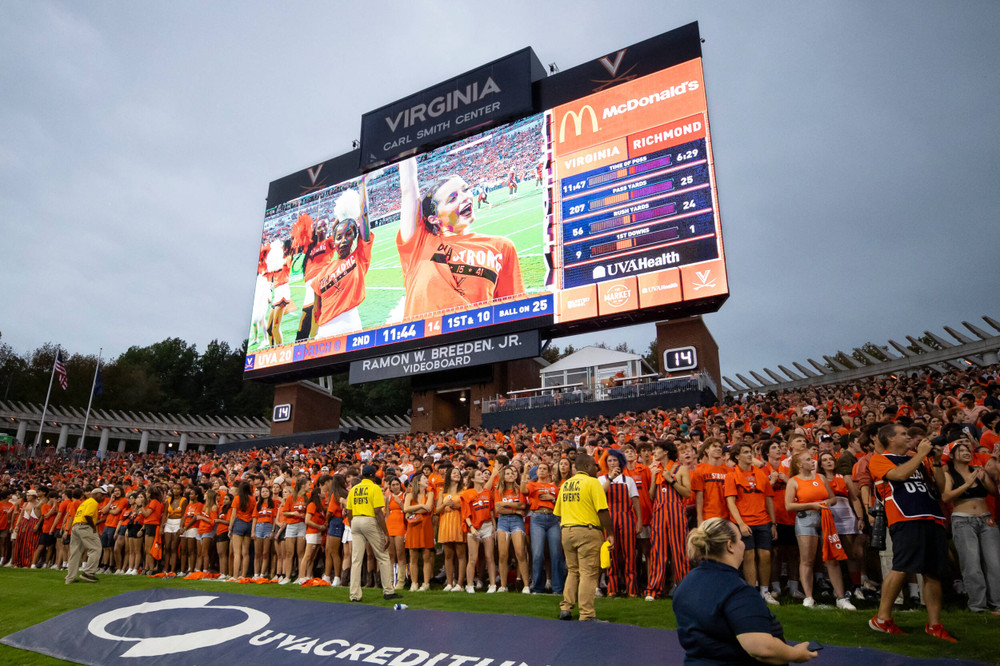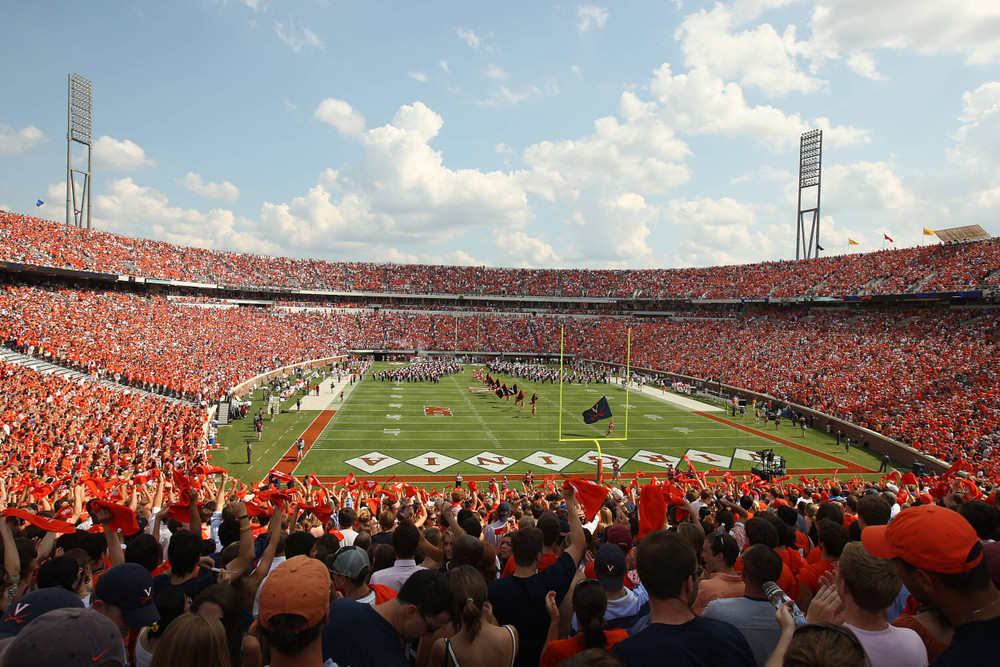Scott Stadium
Home of Virginia FootballCarl Smith Center, home of David A. Harrison III Field at Scott Stadium
Capacity: 61,500
Set against the backdrop of Monticello Mountain and the Blue Ridge Mountains, Scott Stadium is widely regarded as one of the most beautiful venues in college football. The Carl Smith Center, home of David A. Harrison III Field at Scott Stadium, serves as a fitting stage for the University of Virginia’s proud football tradition and reflects the institution’s enduring commitment to excellence.
Originally dedicated in 1931 through the generosity of Frederic William Scott and his family, the stadium has evolved into a modern, full-service facility that blends classic architectural character with contemporary design. A major renovation completed in 2000 expanded capacity to more than 60,000 and introduced new upper decks, luxury suites, expanded concourses, and enhanced amenities throughout the venue.
The natural-grass playing surface—David A. Harrison III Field—was dedicated in 1995 and features advanced turf and drainage systems that ensure premier playing conditions. The addition of the ‘Hoo Vision video board and upgraded sound system further enrich the game day experience for players, coaches, and fans alike.
The most recent upgrade came in 2024 when UVA unveiled the Ramon W. Breeden Jr. Videoboard, a 6,700-square-foot video display and accompanying custom point-source audio system. The new board is more than twice the size of the previous display.
In addition to serving as the home field for Virginia football, Scott Stadium has hosted a variety of major events, including concerts, NCAA men’s lacrosse games, and Virginia high school state football championships. Since the start of the 21st century, internationally renowned artists such as Dave Matthews Band, Neil Young, U2, and The Rolling Stones have performed at the venue. In 2017, Scott Stadium was the site of the Concert for Charlottesville, which featured performances by Coldplay, Ariana Grande, Justin Timberlake, Chris Stapleton, The Roots, Pharrell Williams, Stevie Wonder, and Dave Matthews Band.
On May 24, 2025, Scott Stadium was named the host venue of the 2026 NCAA Men’s Lacrosse Championships, which will commence of Memorial Day weekend. The stadium previously hosted the the NCAA Division I Men’s Championship in both 1977 and 1982. The Cavalier men’s lacrosse team also competed at Scott Stadium in a 2011 regular-season game against Maryland.
Today, Scott Stadium remains a defining landmark of the University and a gathering place where generations of Cavaliers unite to celebrate the spirit and tradition of Virginia football.
Directions
Scott Stadium – 1815 Stadium Rd, Charlottesville, VA 22903
From the East/West: I-64 to exit 118B (Culpeper-Charlottesville). Take second exit (sign will say University of Virginia Information Center and Business 250 East) and bear right onto Ivy Rd. At second stoplight, turn right on to Alderman Rd. Go 8/10ths of a mile and Scott Stadium will be on left side. Parking for football games is at Fontaine Research Park, John Paul Jones Arena, D3 lot and The Park.
From the North: Take Route 29 south into Charlottesville (Emmet St.). Turn right at Ivy Rd. Go the next stoplight and turn left onto Alderman Rd. Stay on Alderman Rd. for 8/10ths of a mile and Scott Stadium will be on left side. Parking for football games is at Fontaine Research Park, John Paul Jones Arena, D3 lot and The Park.
From the South: Take Route 29 to Business Route 250 East (sign will say University of Virginia Information Center) and bear right onto Ivy Rd. At second stoplight, turn right on to Alderman Rd. Go 8/10ths of a mile and Scott Stadium will be on left side. Parking for football games is at Fontaine Research Park, John Paul Jones Arena, D3 lot and The Park.
Scott Stadium Timeline
1974 – New aluminum seating is installed along with an Astroturf playing surface. The facility’s brickwork is restored.
1980 – The stadium’s upper decks open adding 12,000 additional seats. A new press box—named in memory of longtime UVA athletic director Captain Norton Pritchett—and a President’s box are also constructed.
Oct. 9, 1982 – Using portable lights, UVA plays its first night game at Scott Stadium against defending national champion Clemson.
1983 – A permanent lighting system is installed before the start of the season.
1985 – Bryant Hall, a dining and locker room facility located in the south end zone of the stadium, opens. The building is named in honor of J.C. Herbert Bryant, a 1932 Virginia graduate and one of the principal benefactors of the structure.
Nov. 3, 1990 – A stadium-record crowd of 49,700 attends as No. 1 Virginia faces No. 16 Georgia Tech in a nationally televised game. The Yellow Jackets win 41-38.
Sept. 2, 1995 – Virginia dedicates its new natural grass playing field – David A. Harrison III Field – at the first home game of the season against William & Mary. The field is named after David A. Harrison III of Hopewell, Va., who pledged $5 million to support the UVA football program. Harrison Field replaces artificial turf which was first installed at Scott Stadium in 1974.
Nov. 2, 1995 – Virginia hosts Florida State in the first-ever Thursday night game in Charlottesville. Playing in front of a sell-out crowd and a national television audience, the Cavaliers defeat the second-ranked Seminoles 33-28. Florida State becomes the highest-ranked team to ever fall to the Cavaliers.
June 14, 1997 – Representing the largest single monetary gift in school history at that time, UVA alumnus and former Cavalier football player Carl W. Smith pledges $25 million to his alma mater. The University announces that the bulk of Smith’s gift—$23 million—will be used toward funding the expansion and enhancement of Scott Stadium, ultimately increasing its seating capacity to 61,500 by the year 2000.
Sept. 12, 1998 – Located in the north end of the stadium, the ‘Hoo Vision videoboard debuts for the Maryland game. In conjunction with this project, the north end hillside seating area is moved 30 feet closer to the playing field
Sept. 18 1999 – The lower level of the south bowl, including new locker rooms, is finished before the home opener vs. Wake Forest.
Sept. 2, 2000 – The Carl Smith Center, home of David A. Harrison III Field, is dedicated during the 2000 season opener against BYU. The final phase of the stadium renovation project includes the completion of the new Bryant Hall at the Carl Smith Center.
Nov. 17, 2001 – A crowd of 61,625 attends the home game vs. Virginia Tech, the largest attendance for a football game in Virginia state history at the time.
2003 – Video display ribbon board panels are installed below the upper decks on the east and west sides of the stadium.
Oct. 6, 2005 – The legendary rock band The Rolling Stones perform before a sold out crowd.
Aug. 30, 2008 – A record-setting crowd of 64,947 attends the season opener against USC.
2009 – A new 32-foot by 57-foot videoboard replaces the existing 21-foot by 28-foot screen.
Oct. 1 2009 – Rock band U2 brought its famous 360º Tour to a packed Scott Stadium.
2015 – New ribbon board LED displays were installed and run along the fascia between the upper and lower levels completely around the stadium’s horseshoe.
Sept. 9 2023 – The home opener against James Madison was Virginia’s 500th game at Scott Stadium.
Aug. 31, 2024 – A new 6,700-square-foot end zone video display along with a custom point-source audio system debuts for UVA’s season opener against Richmond. The new board is more than twice the size of the previous display.




